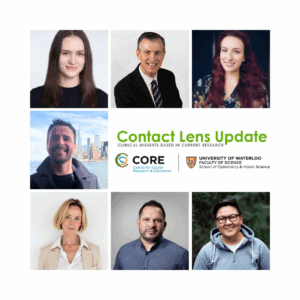Artificial intelligence (AI) is on the verge of reshaping contact lens practices, being incorporated into tools that enhance fitting accuracy, streamline workflows, and personalize treatment. The Centre for Ocular Research & Education (CORE) has dedicated Issue 85 of Contact Lens Update to AI innovations, from smart lenses to data-driven fitting algorithms, that are transforming the management of contact lens wear and ocular surface health. The bi-monthly publication is available at no charge by visiting ContactLensUpdate.com.
“AI breakthroughs are altering the way clinicians approach fitting and monitoring contact lenses, particularly for patients with complex corneal profiles or coexisting ocular surface conditions. As the technology continues to evolve, it holds significant promise for elevating the standard of care and delivering more efficient, customized, and outcome-focused solutions for contact lens wearers,” said Daddi Fadel, clinical scientist at CORE.

Expert Contributors Highlight AI Applications Across Contact Lens Care
Kasandra Swiderska, a research scientist at M-Optometry and honourary research associate at the University of Manchester, and Philip Morgan, a professor of optometry and director of Eurolens Research at the University of Manchester, wrote the issue’s opening editorial. They provide an overview of how AI is revolutionizing contact lens care and explore AI’s current and future role in ocular health, including ortho-k, keratoconus, and smart lens technologies. The authors note that responsible adoption requires consideration of ethical, technical, and clinical aspects.
Rute Macedo de Araújo, an optometrist and vision scientist who earned her doctorate from the University of Minho, focuses on specialty contact lenses, corneal irregularities, and visual quality. She penned the feature article about AI use to identify subtle meibomian gland changes in asymptomatic children wearing ortho-k or myopia control soft lenses. The technology detected early morphological alterations that might go unnoticed with traditional assessment methods, underscoring the potential of AI-based meibography for proactive ocular surface monitoring in pediatric contact lens wearers.

Three members of the eye care community teamed to create the issue’s clinical insight: Ben David, general manager at AOS, who has led innovations in hybrid care software for optical retail over the past six years; optometrist and dry eye specialist Sarah Farrant, a global consultant, educator, and former BCLA president who is passionate about advancing eye care access and education; and Karl Hans Jeebaun, CEO of AOS and Sparca, who has pioneered AI-driven ophthalmic software and holds key roles with eye care innovation and policy groups. Their article highlights the evolution, current applications, and future potential of AI in contact lens practice, supported by real-world case studies that demonstrate improved outcomes and patient satisfaction.
The conference highlight is shared by Andrea Fazio Liu, a research optometrist at the UC Berkeley School of Optometry & Vision Science. This study used an AI-based approach to quantify morphological differences between upper and lower eyelid Meibomian glands in dry eye. Findings revealed significant distinctions in gland length, width, contrast, and tortuosity, highlighting the potential for standardized AI analysis in gland assessment.
In addition to a complete archive of back issues, ContactLensUpdate.com offers a resource library that provides no-cost professional tools, patient resources, images and video. It also houses complimentary technical training videos produced by International Association of Contact Lens Educators, plus an industry glossary. Industry professionals can access the latest issue directly from ContactLensUpdate.com or quickly sign up for email receipt of future issues.
The publication receives support from the educational arms of Alcon, CooperVision, and Johnson & Johnson Vision.